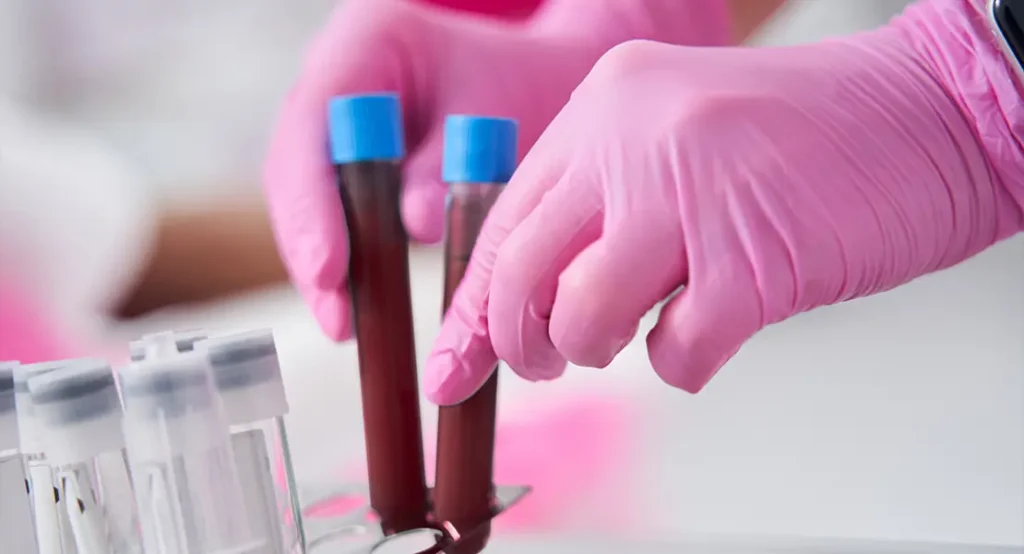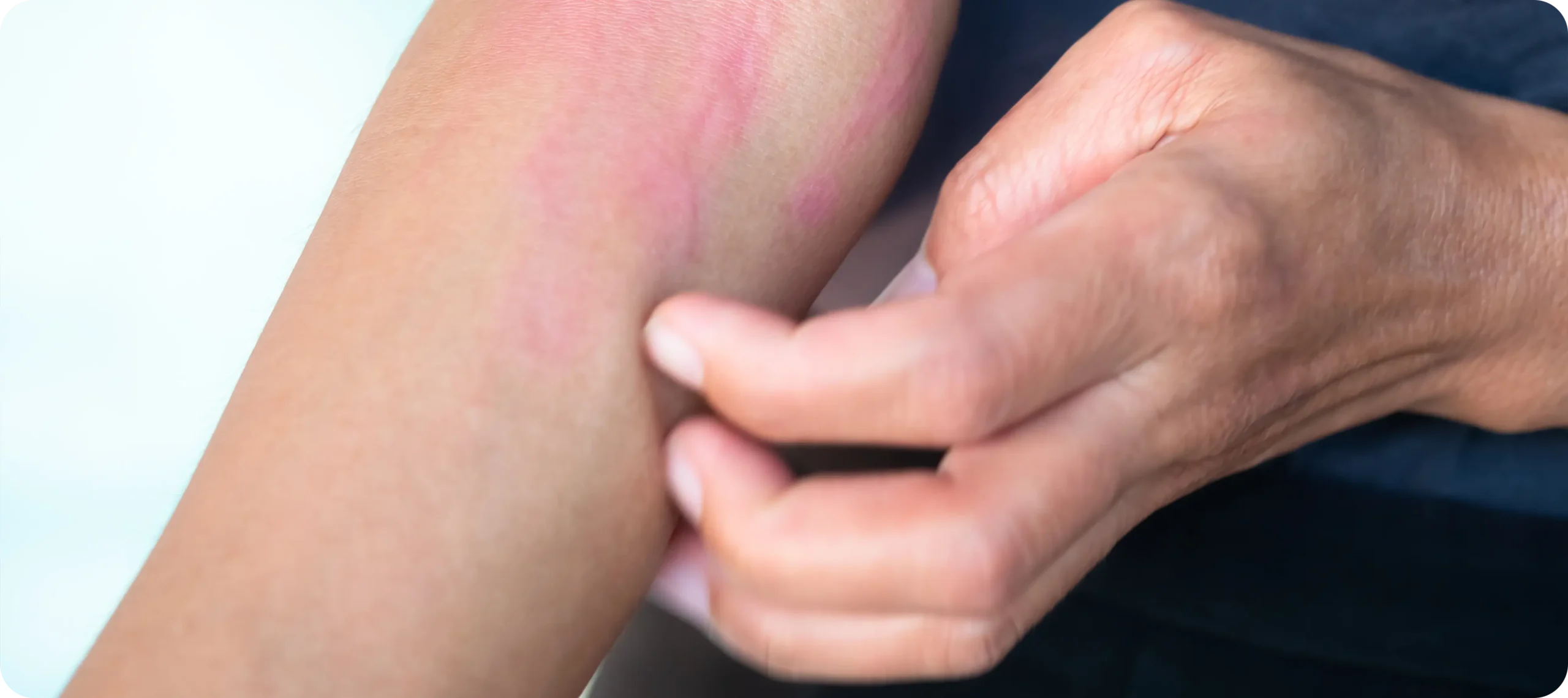If you’ve been dealing with hives that just won’t go away, you’re not alone. Chronic hives, medically referred to as chronic urticaria, can affect daily comfort, confidence, and peace of mind. These red, itchy welts can come and go unpredictably and last for more than six weeks, sometimes persisting for months or even years. Understanding how chronic hives behave and what options you have for managing them can make a significant difference in your day-to-day life.
What Chronic Hives Really Are
At a basic level, chronic hives are itchy, raised patches or welts on your skin. They may appear suddenly and disappear within hours, only to reappear somewhere else later. For a condition to be classified as chronic urticaria, these outbreaks need to continue for at least six weeks. Each individual hive usually fades within 24 hours, but the overall cycle of flare-ups can be persistent.
The condition is generally divided into two types:
- Chronic Spontaneous Urticaria (CSU): If you’ve ever had hives pop up out of nowhere without touching anything unusual or eating something different, you might be dealing with Chronic Spontaneous Urticaria. With this type, the hives come and go without any clear reason—they just seem to have a mind of their own. One day your skin is calm, and the next, you’re suddenly itchy and covered in raised red welts. It’s incredibly frustrating because no matter how carefully you try to track your diet, environment, or routine, you might not find any obvious trigger.
What’s actually happening is that your immune system is acting up. For reasons we don’t always fully understand, certain immune cells in your skin (called mast cells) release histamine, which causes the swelling and itching. In some people, the body may even be attacking itself with autoantibodies, sort of like a glitch in the system. The tricky part is that even though there’s something going on underneath, the usual allergy tests often come back normal. That doesn’t mean it’s in your head—it’s very real, and thankfully, there are good treatments out there to help you get it under control. - Chronic Inducible Urticaria (CIndU): Now, if your hives seem to show up after certain situations—like stepping into cold air, taking a hot shower, or even going out in the sun—you might have Chronic Inducible Urticaria. This type is different because there is a clear trigger. You can probably spot a pattern, which can be both a blessing and a curse. On one hand, knowing what sets off your hives helps you plan ahead. On the other hand, it can make you nervous about everyday things like going for a run or wearing tight clothes that put pressure on your skin.
There are actually lots of subtypes within CIndU. Some people break out from pressure on the skin (called dermatographism), others from heat, cold, vibration, water, or even exercise. The trick is figuring out which one you’re dealing with. Once that’s clear, your doctor can help tailor your treatment, and you can make small adjustments in your routine to avoid flare-ups. Still, it’s not always easy. Trying to dodge your triggers all the time can wear you down, so it’s important to find a balance—and to have the right support while you do it.
You may have one type or a combination of both. Regardless of the type, the symptoms and management strategies share several common threads.
What It Feels Like to Live With Chronic Hives
Living with chronic hives can feel like a daily guessing game. One moment, your skin is clear, and the next, angry red welts start spreading across your arms, legs, or torso for no apparent reason. You might wake up completely fine, go about your day, and then suddenly feel that familiar itch by lunchtime. Or worse, the hives show up just as you’re winding down at night, turning what should be rest into hours of discomfort and tossing in bed. It’s not just the itch—some people experience deeper swelling, called angioedema, that can puff up the lips, eyelids, or even make it hard to swallow, adding a layer of fear to the physical symptoms.
What makes chronic hives particularly hard to deal with is how unpredictable and persistent they are. You never really know when the next flare will hit, which can make simple plans—like going out with friends or wearing certain clothes—feel like a gamble. That uncertainty takes a mental toll. There’s a constant sense of vigilance, like you always have to be on alert. And when the hives do show up, they’re not just irritating—they can be painful, hot, and leave your skin feeling raw or bruised long after they fade. Even though each individual welt disappears within a day, the cycle feels never-ending, like your skin is working against you.

Over time, this can chip away at your confidence and emotional wellbeing. Chronic hives can make you feel isolated, especially when others assume it’s just a mild rash or think you’re overreacting. But when the itching keeps you up at night or you’re self-conscious about visible marks on your skin, it’s hard not to feel frustrated or down. It’s not just a matter of comfort—it’s about dignity, rest, and the freedom to live your life without always having to factor in your skin. Managing chronic hives goes beyond creams and tablets—it means finding ways to take back some control in the midst of a condition that often feels like it has none.
Identifying Possible Triggers
The first step to taking control is trying to work out whether there’s a clear cause. While this isn’t always possible, paying close attention to your habits, routines, and environment can sometimes reveal patterns.
- Medications: Certain drugs are well-known for aggravating chronic hives. Aspirin and other non-steroidal anti-inflammatory drugs (NSAIDs), like ibuprofen, are common culprits. Some people may also react to antibiotics such as penicillin or sulphonamides. If your symptoms flare up after taking medication, that’s worth noting and discussing with your healthcare provider.
- Infections: Chronic infections — especially of the sinuses, gut (like Helicobacter pylori), or urinary tract — can act as aggravating factors. Treating these may not always cure hives completely, but in some cases, improvement is noticeable after the infection is addressed.
- Stress and Anxiety: Stress doesn’t directly cause chronic hives, but it can worsen them. Psychological stress activates the release of chemicals in your body that influence your immune system and skin sensitivity. If you notice flare-ups during stressful periods, there may be a link worth exploring.
- Physical Stimuli: For people with chronic inducible urticaria, specific physical factors can be triggers. Common examples include:
- Cold or heat exposure
- Pressure on the skin (tight clothing or sitting too long)
- Sunlight
- Vibration or friction
- Exercise or sweating
Learning to avoid or minimise exposure to these triggers can reduce the number and severity of episodes.
Common Misconceptions About Food and Allergies
One of the most widespread assumptions is that chronic hives are caused by a food allergy. While food can trigger acute hives in some people, it’s rarely the cause of chronic cases. Elimination diets and food allergy testing often don’t offer clear answers and can sometimes lead to unnecessary restrictions.
That said, some people find their symptoms improve when they avoid histamine-rich foods, such as:
- Aged cheese
- Alcohol
- Smoked meats
- Fermented foods
- Vinegar-containing products
Trying a low-histamine diet for a couple of weeks, under proper supervision, may be helpful. However, it should not be a long-term or overly restrictive approach unless there’s clear benefit.

Tracking Your Symptoms
Keeping a symptom diary can be surprisingly effective. Write down:
- When hives appear
- What you ate
- Activities you did
- Medications taken
- Stress levels
- Environmental exposure (e.g. cold air or exercise)
Over time, patterns may begin to emerge. This helps in identifying triggers and gauging the effectiveness of different treatment strategies.
The Role of Blood Tests and Investigations
If your symptoms are persistent and unexplained, your doctor may suggest some basic tests. These aren’t designed to confirm chronic hives — the diagnosis is usually made based on symptoms alone — but rather to rule out underlying issues.
Common tests include:
- Full blood count
- Markers of inflammation (like ESR or CRP)
- Liver and kidney function
- Thyroid function and thyroid antibodies
- Total IgE levels
In most cases, these tests come back normal, which can be reassuring. More specialised tests may be considered if your hives are especially severe, involve angioedema, or don’t respond to standard treatments.

First-Line Treatment: Non-Sedating Antihistamines
The go-to treatment for chronic hives is non-sedating antihistamines. These medications work by blocking histamine, one of the chemicals your body releases during a hive outbreak.
Examples include:
- Fexofenadine
- Loratadine
- Cetirizine
- Levocetirizine
You usually start with the standard dose, but for chronic cases, your doctor might gradually increase this — sometimes up to four times the regular dose. This is considered safe in the long term and often necessary to get proper control.
Other Medication Options
If regular antihistamines aren’t enough, there are additional treatment options that might be added or substituted.
- Sedating Antihistamines: Sometimes, a night-time antihistamine like hydroxyzine or chlorphenamine can help with sleep and offer extra itch relief. They tend to cause drowsiness, so they’re not ideal during the day.
- Montelukast: This is a leukotriene receptor antagonist typically used in asthma. For some people, particularly those who react to aspirin, it offers added benefit when used alongside antihistamines.
- Corticosteroids: Short courses of oral steroids (like prednisolone) can be prescribed for acute flare-ups. They’re effective in the short term but are not suitable for long-term use due to side effects like weight gain, high blood pressure, and bone thinning.
- H2 Blockers: These are usually used for stomach acid but can also help in combination with H1 antihistamines. Examples include famotidine and ranitidine (though ranitidine has been withdrawn in many countries).
Advanced Treatments for Resistant Cases
If your hives don’t improve despite high-dose antihistamines and supportive therapies, there are advanced options available.
Omalizumab
This biologic injection is used for people with antihistamine-resistant chronic spontaneous urticaria. It targets a specific immune molecule (IgE) involved in allergic responses. Given once a month, it has transformed care for many people with severe cases. It does require monitoring and may not be instantly accessible everywhere.
Ciclosporin
In very stubborn cases, ciclosporin — an immunosuppressive drug — may be considered. It can be effective but comes with more serious potential side effects, such as kidney issues and high blood pressure, so careful supervision is needed.
Managing Angioedema
Angioedema feels very different from the surface-level itch and rash of hives. It causes a much deeper kind of swelling, often making your skin look puffed up or stretched, and it can be quite uncomfortable or even painful. You might notice this swelling around your lips, cheeks, eyes, or even on your hands and feet. Unlike hives, which tend to rise and fade quickly, angioedema can last longer and often leaves the skin tender afterwards. If it affects your throat or tongue, it can become especially concerning, making it feel tight or difficult to swallow — which can understandably cause anxiety.
Sometimes angioedema comes hand-in-hand with hives, but in other cases, it appears completely on its own. When it shows up without the telltale welts, it’s important to take a closer look at what might be going on beneath the surface. In some people, it could be related to a rare genetic condition called hereditary angioedema, which doesn’t respond to the usual antihistamines used for hives. In others, the swelling might be triggered by certain medications, particularly those used to control blood pressure, like ACE inhibitors. If you’re not breaking out in hives but keep getting unexplained swelling, it’s a strong signal that your doctor needs to investigate further.
Getting an accurate diagnosis is essential because the treatment plan can vary significantly depending on the cause. While histamine-blocking medications like antihistamines or corticosteroids can be helpful in allergy-related angioedema, they won’t do much if your swelling is caused by a medication reaction or a genetic deficiency. In those cases, you’ll need more targeted therapies or changes to your regular medications. So if you notice swelling that’s unusual, especially if it affects your breathing or doesn’t follow your typical pattern of hives, don’t try to self-manage — speak to a healthcare professional as soon as possible. Getting the right diagnosis is the first step in regaining a sense of control.
Mental Health and Emotional Impact
Living with chronic hives can be mentally exhausting. Constant itching, the unpredictability of outbreaks, and visible marks on your skin can affect your confidence, sleep, and social interactions. It’s not uncommon to feel frustrated, anxious, or even depressed.

Psychological support — whether through talking therapies, relaxation techniques, or online support groups — can play a valuable role in your overall management. Managing stress more effectively can also contribute to reducing flare-ups.
What You Can Do at Home
In addition to medication, there are practical steps you can take to reduce symptoms and improve comfort.
- Keep skin cool: Avoid hot showers, tight clothing, or overheating. Cotton clothing is often gentler on sensitive skin.
- Use fragrance-free skincare: Soaps and lotions with fragrance can worsen irritation.
- Avoid known triggers: Whether it’s a food, medication, or environmental factor, steering clear can reduce the frequency of outbreaks.
- Stick to a regular treatment schedule: Don’t skip antihistamines, even on days without symptoms, unless advised.
Chronic Hives in Children
Children can also develop chronic urticaria, though it’s less common than in adults. In children, infections or minor allergies may play a larger role. The approach to treatment is broadly the same, using weight-appropriate antihistamines. Long-term outcomes in children are generally favourable, with most outgrowing the condition.
When to See a Specialist
You should consider seeing a specialist if:
- Your symptoms persist despite regular antihistamines
- Angioedema is present, especially without hives
- You experience difficulty breathing or swallowing
- There’s significant disruption to your daily life
- You’re considering advanced treatments like omalizumab
A specialist can offer more in-depth evaluation, identify less common causes, and guide you through the options for more complex cases.

Prognosis: How Long Does It Last?
While chronic hives can be persistent, they often improve over time. Studies show that about half of people with CSU go into remission within a year. Most will see symptoms settle within five years, especially with proper treatment and trigger avoidance.
Inducible urticaria may last longer if the triggers are unavoidable, but even in these cases, symptoms can become less severe over time.
Final Thoughts
Chronic hives can be overwhelming, especially when symptoms are unpredictable and disruptive. But you’re not without options. From identifying triggers and using the right medications to exploring advanced treatments when needed, there is a path to getting your symptoms under control.
Tracking your condition, working with your doctor, and staying informed can make a real difference. While it might take time to find what works best for you, relief is absolutely possible — and in many cases, achievable without overly complex interventions.
If you’re struggling with chronic hives, you don’t have to face it alone. You can contact us at The London Dermatology Centre to book a consultation with one of our expert dermatologists. We’re here to help you find the right approach for your skin and get you back to feeling more comfortable in your day-to-day life.
